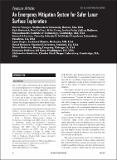An Emergency Mitigation System for Safer Lunar Surface Exploration
Author(s)
Vanegas, Morris; Kotowick, Kyle Jordan; LaTour, Paul; Curry, Michael Dale; Foley, Jordan; Hoffman, Jeffrey; Schreiner, Samuel; Setterfield, Timothy; Geiger, Lynn; Barmore, David; Roberson, Daniel; Putbrese, Benjamin; Stankovic, Aleksandra; ... Show more Show less
Download08766177-2.pdf (2.871Mb)
Terms of use
Metadata
Show full item recordAbstract
One of the central achievements of the Apollo program was the development of rover vehicles which significantly increased the range and scientific capabilities of lunar surface exploration. Given the mission specifications of the Apollo program—which generated a combined total of 3 days and 6 hours of lunar surface Extra-Vehicular Activity (EVA) time—the Apollo 15, 16, and 17 mission vehicles were designed primarily for short-duration exploration. However, as proposed future space exploration looks ahead to longer duration missions, and perhaps even to the establishment of a permanent manned lunar presence [1], the capabilities of unpressurized rover vehicles must be expanded, not only in terms of surface range, but also in their ability to tolerate unexpected emergency scenarios.
Date issued
2019-05-01Department
Charles Stark Draper Laboratory; Massachusetts Institute of Technology. Department of Aeronautics and AstronauticsJournal
IEEE Aerospace and Electronic Systems Magazine
Publisher
Institute of Electrical and Electronics Engineers (IEEE)
Citation
Vanegas, Morris et al. "An Emergency Mitigation System for Safer Lunar Surface Exploration." IEEE Aerospace and Electronic Systems Magazine 34, 5 (May 2019): 42-52 © 2019 IEEE
Version: Author's final manuscript
ISSN
0885-8985
1557-959X
Keywords
Space and Planetary Science, Electrical and Electronic Engineering, Aerospace Engineering